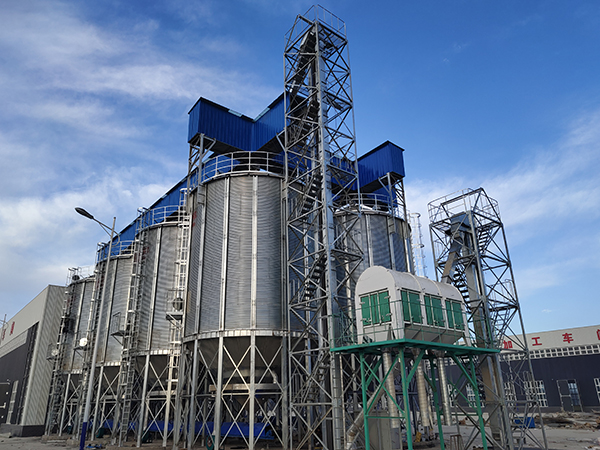How to Achieve Efficient Storage in a Barley Cone Bottom Silo?
This article explains the efficient storage of barley in cone bottom silos, detailing the silo’s components and the process of barley entry, ensuring grain safety and ease of management. It also invites readers with grain storage needs to get in touch for further assistance.
- Barley grain bin company in Tanzania
- rice grain bin factory in Rwanda
- Paddy grain bin supplier in Guinea
- Wheat Cone-Bottom Silo Franchise in Thailand
- Wheat cone bottom silo procurement in Thailand
- Wholesale Wheat Cone-Bottom Silo in Malaysia
- Manufacturers of Wheat Cone-Bottom Silo in Malaysia
- Wheat Cone-Bottomed Silo Suppliers in Uganda
- Cone-Bottom Wheat Silo Sales in Uganda
- Wheat cone bottom silo price in Uganda
- Soybean meal grain bin sale in Guinea
- Corn grain bin price in Libya
Barley cone bottom silo ensure grain safety and quality with their unique structure. They also ensure convenience in the storage process through efficient management procedures. This article will guide you on how to achieve efficient storage of barley.
Components of a Barley Cone Bottom Silo
A barley cone bottom silo is a highly efficient storage facility designed specifically for barley storage. Its structural components ensure grain safety and storage efficiency.
Silo Body Structure:
The silo body is the main part of the silo, typically made from hot-dip galvanized steel plates for excellent corrosion resistance. The thickness of the galvanized layer ranges from 275 to 600g/m², ensuring durability and rust resistance. Our corrugated steel plate production line is controlled by advanced numerical control equipment, ensuring production precision and quality.
Bolts and Nuts:
Bolts and nuts in the silo also undergo hot-dip galvanizing to enhance their corrosion resistance and structural strength. These fasteners feature hexagonal flanges, ensuring maximum sealing of connections and extending service life.
Reinforcement Structures:
The side wall reinforcement ribs are made of steel with a minimum tensile strength of 350 N/mm². This material effectively transmits vertical and environmental loads during loading and unloading. Precise calculation and layout of the ribs ensure the overall strength and safety of the silo. Ribs can be installed on the inside or outside to meet different design requirements.


Wind Ring Support:
To withstand the effects of high wind pressure areas, wind rings directly connect to the reinforcement ribs, providing additional support. These ring reinforcement structures help the silo resist destructive winds, ensuring stability.
Doors and Platforms:
The silo’s door platform includes a standard manhole door located within the second ring of the silo. This door is designed for dual sizes, equipped with a sturdy frame and block system for easy daily inspection and maintenance while ensuring silo safety.
Ladder System:
For easy access and maintenance, the silo is equipped with ladders and stairs. These structures are fitted with handrails or safety devices to ensure safe use. Stairs can be installed internally or externally to meet different access needs.
Internal Ladders:
The internal ladders of the silo are simply designed, offering a choice between vertical ladders or cage ladders. These ladders provide a convenient passage for operators to conduct internal inspections and maintenance while ensuring safety.


How Does Barley Enter the Cone Bottom Silo?
As a widely cultivated grain crop, barley storage requires special attention. Here are the specific steps for barley to enter the cone bottom silo:
Initial Weighing:
Firstly, barley is weighed using an automated weighing system. This step ensures the accuracy of the storage quantity and provides basic data for subsequent inventory management.
Transportation to Grain Pit:
Weighed barley is transported to the grain pit area. The grain pit is a concave structure at the silo entrance, used for temporarily storing and concentrating barley before the next cleaning step.
Cleaning Impurities:
Barley is elevated to a cleaning screen for de-stoning. The cleaning screen removes impurities and dust such as stones and straw from barley. The parameters of the screen can be adjusted as needed to control the degree of cleaning and ensure barley cleanliness meets storage standards.
Elevated Again to Silo:
Thoroughly cleaned barley is elevated again, this time directly into the storage silo. During this process, the elevator ensures smooth transportation of barley, reducing potential losses during handling.
Stored in the Silo:
Finally, barley is safely stored in the cone bottom silo. The design of the silo allows for easy automatic outflow of barley through the conical bottom when needed, facilitating subsequent loading and transportation.


Contact Us
If you have grain storage needs, please feel free to contact us.








